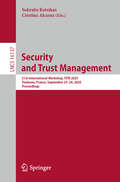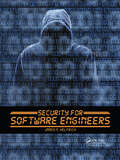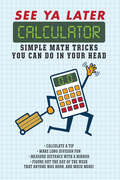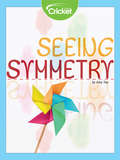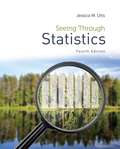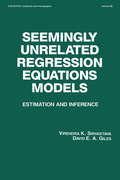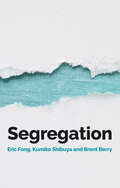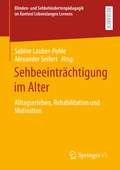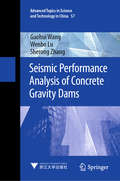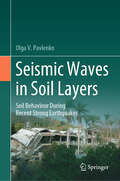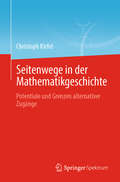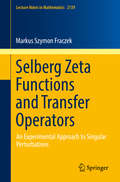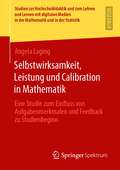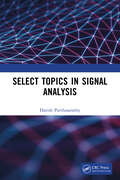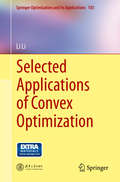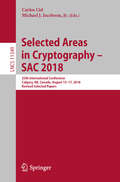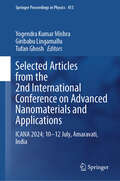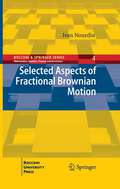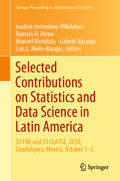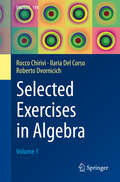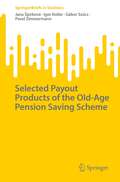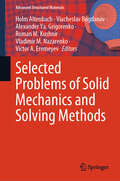- Table View
- List View
Security and Trust Management: 21st International Workshop, STM 2025, Toulouse, France, September 25–26, 2025, Proceedings (Lecture Notes in Computer Science #16137)
by Sokratis Katsikas Cristina AlcarazThis book constitutes the proceedings of the 21st International Workshop on Security and Trust Management, STM 2025, held in conjunction with the 30th European Symposium on Computer Security Research (ESORICS 2025), in Toulouse, France, during September 25–26, 2025. The 13 full papers presented in this book were carefully reviewed and selected from 26 submissions. They were organized in topical sections as follows: Identity Management, Authentication, Access Control & Formal Modeling; AI & Machine Learning for Security; Cybersecurity Strategies, Regulations, Privacy; Cryptography & Threat Analysis.
Security for Software Engineers
by James N. HelfrichSecurity for Software Engineers is designed to introduce security concepts to undergraduate software engineering students. The book is divided into four units, each targeting activities that a software engineer will likely be involved in within industry. The book explores the key areas of attack vectors, code hardening, privacy, and social engineering. Each topic is explored from a theoretical and a practical-application standpoint. Features: <P><P> Targets software engineering students - one of the only security texts to target this audience. <P><P> Focuses on the white-hat side of the security equation rather than the black-hat side. <P><P> Includes many practical and real-world examples that easily translate into the workplace. <P><P> Covers a one-semester undergraduate course. <P><P> Describes all aspects of computer security as it pertains to the job of a software engineer and presents problems similar to that which an engineer will encounter in the industry. <P><P> This text will equip students to make knowledgeable security decisions, be productive members of a security review team, and write code that protects a user’s information assets.
Sedentary Behaviour Epidemiology (Springer Series on Epidemiology and Public Health)
by Michael F. Leitzmann Carmen Jochem Daniela SchmidThis book addresses the origins, determinants and magnitude of the global problem of sedentary behaviour, along with concise yet in-depth solutions for tackling it. As a consequence of major technological advances in modern society, many people find themselves in environments characterized by prolonged sedentary behaviour. Building on the contributions of leading experts in the field, the new edition of this book presents updated knowledge about sedentary behaviour, its medical and public health significance, its correlates and determinants, measurement techniques, and recommendations for addressing this behaviour at the individual, community, environmental, and policy level. The book encompasses current research linking the COVID-19 pandemic to increased levels of sedentary behavior, and it covers global and planetary health aspects of sedentary behavior, highlighting sustainable development goals such as health and well-being for all. Applying a cross-disciplinary methodology, the book avoids considering physical activity and sedentary behavior as a single continuum, which potentially hampers progress in confronting widespread levels of sedentariness. Rather, the book helps readers better understand how sedentary and physically active behavior co-occur and how the two behaviours have distinct contributing factors. Building on the contributions of distinguished international experts in the field, this thorough resource is a valuable asset and challenges professionals, researchers, students, and practitioners alike to adopt new strategies and expand their reach.
See Ya Later Calculator: Simple Math Tricks You Can Do in Your Head
by Editors of Portable PressThe math book for anyone who thinks they hate math, full of easy, entertaining and practical tricks for mentally solving problems in seconds.No matter how much you might try to avoid numbers, we all use math every day to calculate a tip, figure out an interest rate, or estimate the cost of the groceries in your cart. But the good news is, math can be easy—and even fun—if you know how to do it all in your head.With these simple and downright magical math tricks, you can do everyday math faster than it takes to dig out your phone and find the calculator app. Step-by-step and easy-to-memorize directions show more than 125 math operations anyone can do in their head.Plus, it features do-it-yourself math projects, puzzles, and a bonus section for advanced mathophiles. Get ready to tackle problems such as . . .• How to easily square any number • How to add three-digit numbers • How to use a mirror to measure the height of a building • How to make a ruler out of a dollar bill • How to use geometry to paint walls, cut floor tiling, and do other home renovations • How to subtract numbers . . . by adding And lots more . . . No calculator required.
Seeing Symmetry
by Amy TaoJoin us as we go on a journey into the world of symmetry! Learn about the wonders of line symmetry—or reflection—as you create mirror images and watch how rotational symmetry works in this brief peek into this area of geometry.
Seeing Through Statistics (Fourth Edition)
by Jessica M. UttsDevelops statistical literacy and critical thinking through real-world applications, with an emphasis on ideas, not calculations. This text focuses on the key concepts that educated citizens need to know about statistics.
Seemingly Unrelated Regression Equations Models: Estimation and Inference
by Virendera K. Srivastava David E.A. GilesThis book brings together the scattered literature associated with the seemingly unrelated regression equations (SURE) model used by econometricians and others. It focuses on the theoretical statistical results associated with the SURE model.
Segregation
by Eric Fong Brent Berry Kumiko ShibuyaSegregation is one of the starkest social realities of contemporary societies. Though often associated with explicitly racist laws of the past, it is a phenomenon that persists to this day and is a crucial element for understanding group relations and the wellbeing of different populations in society. In this book, Eric Fong and Kumiko Shibuya provide a thorough discussion of the evolving complexity of segregation in all its variety and variations. The authors focus not only on past trends and the development of segregation measures, but also the current state of affairs, and demonstrate the connections between the segregation of racial/ethnic groups, immigrant communities, and schools, along with poverty concentration. By taking a wide, cross-cutting view, the authors identify commonalities and differences in the causes, mechanisms, and consequences of segregation. Spatial and social segregation together perpetuate and reinforce the unequal distribution of resources among racial and ethnic groups, which in turn can have positive and negative consequences for individuals and groups. This critical overview of segregation will be a valuable and insightful resource for students of sociology, geography, and ethnic studies, as well as those keen to get a handle on this persistent challenge to equal and inclusive societies.
Sehbeeinträchtigung im Alter: Alltagserleben, Rehabilitation und Motivation (Blinden- und Sehbehindertenpädagogik im Kontext Lebenslangen Lernens)
by Sabine Lauber-Pohle Alexander SeifertSehbeeinträchtigungen im Alter zu erfahren, gehört für zunehmend mehr Menschen zu einer herausfordernden Alltagssituation. Das Buch nimmt sich dieser Lebenssituation der Seniorinnen und Senioren an und diskutiert anhand von theoretischen, empirischen und praxisevaluierenden Beiträgen die Vielfalt der sinnesbeeinträchtigenden Herausforderung im Alltag der älteren Menschen. Mit dem Buch präsentieren Expertinnen und Experten aus dem deutschsprachigen Raum ihre Forschungsergebnisse und beschreiben ihre Beratungsprojekte. Sie liefern so einen Fundus für die praktische Arbeit mit älteren Menschen.
Seismic Imaging and Inversion
by Robert H. Stolt Arthur B. WegleinExtracting information from seismic data requires knowledge of seismic wave propagation and reflection. The commonly used method involves solving linearly for a reflectivity at every point within the Earth, but this book follows an alternative approach which invokes inverse scattering theory. By developing the theory of seismic imaging from basic principles, the authors relate the different models of seismic propagation, reflection and imaging - thus providing links to reflectivity-based imaging on the one hand and to nonlinear seismic inversion on the other. The comprehensive and physically complete linear imaging foundation developed presents new results at the leading edge of seismic processing for target location and identification. This book serves as a fundamental guide to seismic imaging principles and algorithms and their foundation in inverse scattering theory and is a valuable resource for working geoscientists, scientific programmers and theoretical physicists.
Seismic Performance Analysis of Concrete Gravity Dams (Advanced Topics in Science and Technology in China #57)
by Gaohui Wang Wenbo Lu Sherong ZhangThis book evaluates the seismic performance of concrete gravity dams, considering the effects of strong motion duration, mainshock-aftershock seismic sequence, and near-fault ground motion. It employs both the extended finite element method (XFEM) and concrete damaged plasticity (CDP) models to characterize the mechanical behavior of concrete gravity dams under strong ground motions, including the dam-reservoir-foundation interaction. In addition, it discusses the effects of the initial crack, earthquake direction, and cross-stream seismic excitation on the nonlinear dynamic response to strong ground motions, and on the damage-cracking risk of concrete gravity dams.This book provides a theoretical basis for the seismic performance evaluation of high dams, and can also be used as a reference resource for researchers and graduate students engaged in the seismic design of high dams.
Seismic Waves in Soil Layers: Soil Behaviour During Recent Strong Earthquakes
by Olga V. PavlenkoThis book describes recent studies of soil behaviour in strong ground motion – one of the most important and problematic issues in engineering seismology. Destructive earthquakes worldwide show us the damage of structures located on soil foundations; therefore, reliable and adequate estimations of in situ soil behaviour during strong motion are needed. The effects of soil response proved to be more complicated and diverse than we thought previously. Additionally to well-known amplification of seismic waves in near-surface softer layers, resonant phenomena and nonlinearity of soil response, during the 2011 Tohoku earthquake, we observed soil hardening and generation of abnormally high accelerations. The author suggests a method for studying these effects in situ, to forecast soil behaviour in future earthquakes. The method is based on processing records of seismic vertical arrays, which are widely developed in the world and should help us in understanding soil response during earthquakes.The book is addressed to a wide range of seismologists, geotechnical earthquake engineers and physicists.
Seitenwege in der Mathematikgeschichte: Potentiale und Grenzen alternativer Zugänge
by Christoph KirfelIn diesem Buch werden Methoden aus der Geschichte der Mathematik dargestellt, die nicht zu Standardmethoden geworden sind oder es gar bis in klassische Schulbücher geschafft haben. Diese alternativen Zugänge waren oftmals zum Zeitpunkt ihrer Entstehung aktuell und im Gespräch, haben dann aber gegenüber den heutigen Standardmethoden an Aufmerksamkeit verloren und sind schließlich in Vergessenheit geraten. Oftmals enthalten diese Methoden noch ein ungenutztes Potential: Es lohnt sich, sie weiterzuentwickeln und zu entdecken, wo genau sich ihre Grenzen befinden. Das Buch möchte insbesondere angehenden Lehrkräften einen Blick über die üblichen Lehrinhalte hinaus ermöglichen und inhaltliche Anregungen für die Arbeit mit interessierten und begabten Schülerinnen und Schülern liefern. Archimedes etwa entwickelte eine Methode zur Berechnung des Flächeninhaltes eines Parabelsegmentes, die gewissermaßen ein Stück der Integralrechnung vorwegnimmt. Archimedes' Methode entwickelte sich aber nicht zur Standardmethode, wie man sie in heutigen Lehrbüchern wiederfindet. Dort findet man stattdessen die Methoden, die von Newton und Leibnitz entworfen wurden. Dieses Buch entwickelt die Archimedische Methode weiter und zeigt ihr „Restpotential“ auf: Andere Kurven, nicht nur Parabeln, lassen sich ähnlich angreifen und es ist interessant und lehrreich zu sehen, wie weit sich Archimedes' Methode entwickeln lässt und wo sie dann letztlich an ihre Grenzen stößt.
Selberg Zeta Functions and Transfer Operators
by Markus Szymon FraczekThis book presents a method for evaluating Selberg zeta functions via transfer operators for the full modular group and its congruence subgroups with characters. Studying zeros of Selberg zeta functions for character deformations allows us to access the discrete spectra and resonances of hyperbolic Laplacians under both singular and non-singular perturbations. Areas in which the theory has not yet been sufficiently developed, such as the spectral theory of transfer operators or the singular perturbation theory of hyperbolic Laplacians, will profit from the numerical experiments discussed in this book. Detailed descriptions of numerical approaches to the spectra and eigenfunctions of transfer operators and to computations of Selberg zeta functions will be of value to researchers active in analysis, while those researchers focusing more on numerical aspects will benefit from discussions of the analytic theory, in particular those concerning the transfer operator method and the spectral theory of hyperbolic spaces.
Selbstbestimmter Tourismus am Beispiel der Kanarischen Inseln: Abhängigkeiten reduzieren – Zielkonflikte entschärfen – Diversifikation ermöglichen
by Harald Pechlaner Christian Eckert Antonio Garzón Beckmann Valentin Herbold Werner SülbergDie Kanarischen Inseln, deren Topographie stets herausfordernd für eine wettbewerbsfähige Tourismusstrategie war, dienen als Fallstudie zur Transformation hin zu einem nachhaltigen Tourismusmodell samt den damit verbundenen strategischen Herausforderungen und Zielkonflikten. Als Spiegelbild der Entwicklung des Reisens in den europäischen Ländern stehen die Kanaren für sich verändernde Lebensstile der Quellmärkte sowie für die Entwicklung und den Wandel des Reiseveranstalterwesens. Selbstbestimmter Tourismus bedeutet, eine bewusste Entscheidung für Zukunftsszenarien der Inseln zu entwickeln und abgestimmt zu sein zwischen Unternehmertum, Politik und Wissenschaft, um gemeinsam mit den nationalen und internationalen Reiseunternehmen geeignete Strategien zum Wohle des gesamten Tourismus-Netzwerkes „Kanarische Inseln“ zu finden.
Selbstwirksamkeit, Leistung und Calibration in Mathematik: Eine Studie zum Einfluss von Aufgabenmerkmalen und Feedback zu Studienbeginn (Studien zur Hochschuldidaktik und zum Lehren und Lernen mit digitalen Medien in der Mathematik und in der Statistik)
by Angela LagingDie vorliegende Arbeit widmet sich dem Problem der Selbsteinschätzung, insbesondere Überschätzung, in Mathematik bei Studienanfängerinnen. Die quantitative Studie untersucht den Einfluss von Aufgabenmerkmalen und Feedback auf die mathematische Leistung, Selbstwirksamkeitserwartung und Calibration bei Studienanfänger/innen wirtschaftswissenschaftlicher Studiengänge. Die Untersuchungen zeigen, dass vor allem Aufgabenmerkmale wie die curriculare Wissensstufe und der Bearbeitungsumfang die Selbstwirksamkeitserwartung und die tatsächlich erbrachte Leistung auf unterschiedliche Weise beeinflussen. Innerhalb des ersten Studiensemesters verändern sich bei der untersuchten Kohorte Selbstwirksamkeitserwartung und Leistung, wodurch eine deutliche Reduzierung der Selbstüberschätzung erreicht wurde. Inwieweit das Feedback dazu beigetragen hat, kann methodisch bedingt nicht eindeutig festgestellt werden. Die Autorin Angela Laging ist Lehrerin für Mathematik und Kunst an einem Gymnasium.
Select Topics in Signal Analysis
by Harish ParthasarathyThis book developed from a course given by the author to undergraduate and postgraduate students. It takes up Matrix Theory, Antenna Theory, and Probability Theory in detail. The first chapter on matrix theory discusses in reasonable depth the theory of Lie Algebras leading upto Cartan’s Classification Theory. It also discusses some basic elements of Functional Analysis and Operator Theory in infinite dimensional Banach and Hilbert spaces. The second chapter discusses Basic Probability Theory and the topics discussed find applications to Stochastic Filtering Theory for differential equations driven by white Gaussian noise. The third chapter is on Antenna Theory with a focus on Modern Quantum Antenna Theory. The book will be a valuable resource to students and early career researchers in the field of Mathametical Physics.
Selected Applications of Convex Optimization
by Li LiThis book focuses on the applications of convex optimization and highlights several topics, including support vector machines, parameter estimation, norm approximation and regularization, semi-definite programming problems, convex relaxation, and geometric problems. All derivation processes are presented in detail to aid in comprehension. The book offers concrete guidance, helping readers recognize and formulate convex optimization problems they might encounter in practice.
Selected Areas in Cryptography – SAC 2018: 25th International Conference, Calgary, AB, Canada, August 15–17, 2018, Revised Selected Papers (Lecture Notes in Computer Science #11349)
by Carlos Cid Michael J. Jacobson Jr.This book contains revised selected papers from the 25th International Conference on Selected Areas in Cryptography, SAC 2018, held in Calgary, AB, Canada in August 2018. The 22 full papers presented in this volume were carefully reviewed and selected from 57 submissions. They cover the following research areas:design and analysis of symmetric key primitives and cryptosystems, including block and stream ciphers, hash functions, MAC algorithms, and authenticated encryption schemesefficient implementations of symmetric and public key algorithmsmathematical and algorithmic aspects of applied cryptologycryptography for the Internet of Things
Selected Articles from the 2nd International Conference on Advanced Nanomaterials and Applications: ICANA 2024; 10-12 July, Amaravati, India (Springer Proceedings in Physics #413)
by Yogendra Kumar Mishra Giribabu Lingamallu Tufan GhoshThis book comprises selected articles from the 2nd International Conference on Advanced Nanomaterials and Applications (ICANA 2024) held from 10 to 12 July at Amaravati in India. It presents recent developments in the fields of nanoscale sciences. The topics covered in this book include energy storage and conversion, bio- and healthcare materials, sensors and actuators, functional materials, optical materials, and computational and simulation methods. This book is useful for researchers and professionals working in the various fields of nano- and material science.
Selected Aspects of Fractional Brownian Motion
by Ivan NourdinFractional Brownian motion (fBm) is a stochastic process which deviates significantly from Brownian motion and semimartingales, and others classically used in probability theory. As a centered Gaussian process, it is characterized by the stationarity of its increments and a medium- or long-memory property which is in sharp contrast with martingales and Markov processes. FBm has become a popular choice for applications where classical processes cannot model these non-trivial properties; for instance long memory, which is also known as persistence, is of fundamental importance for financial data and in internet traffic. The mathematical theory of fBm is currently being developed vigorously by a number of stochastic analysts, in various directions, using complementary and sometimes competing tools. This book is concerned with several aspects of fBm, including the stochastic integration with respect to it, the study of its supremum and its appearance as limit of partial sums involving stationary sequences, to name but a few. The book is addressed to researchers and graduate students in probability and mathematical statistics. With very few exceptions (where precise references are given), every stated result is proved.
Selected Contributions on Statistics and Data Science in Latin America: 33 FNE and 13 CLATSE, 2018, Guadalajara, Mexico, October 1−5 (Springer Proceedings in Mathematics & Statistics #301)
by Ramsés H. Mena Isadora Antoniano-Villalobos Manuel Mendoza Lizbeth Naranjo Luis E. Nieto-BarajasThe volume includes a collection of peer-reviewed contributions from among those presented at the main conference organized yearly by the Mexican Statistical Association (AME) and every two years by a Latin-American Confederation of Statistical Societies. For the 2018 edition, particular attention was placed on the analysis of highly complex or large data sets, which have come to be known as “big data”. Statistical research in Latin America is prolific and research networks span within and outside the region. The goal of this volume is to provide access to selected works from Latin-American collaborators and their research networks to a wider audience. New methodological advances, motivated in part by the challenges of a data-driven world and the Latin American context, will be of interest to academics and practitioners around the world.
Selected Exercises in Algebra: Volume 1 (UNITEXT #119)
by Rocco Chirivì Roberto Dvornicich Ilaria Del CorsoThis book, the first of two volumes, contains over 250 selected exercises in Algebra which have featured as exam questions for the Arithmetic course taught by the authors at the University of Pisa. Each exercise is presented together with one or more solutions, carefully written with consistent language and notation. A distinguishing feature of this book is the fact that each exercise is unique and requires some creative thinking in order to be solved. The themes covered in this volume are: mathematical induction, combinatorics, modular arithmetic, Abelian groups, commutative rings, polynomials, field extensions, finite fields. The book includes a detailed section recalling relevant theory which can be used as a reference for study and revision. A list of preliminary exercises introduces the main techniques to be applied in solving the proposed exam questions. This volume is aimed at first year students in Mathematics and Computer Science.
Selected Payout Products of the Old-Age Pension Saving Scheme (SpringerBriefs in Statistics)
by Jana Špirková Igor Kollár Gábor Szűcs Pavel ZimmermannThis book discusses the payout phase of the old-age pension saving scheme, the so-called effective premium, and offers detailed actuarial models and analyses of five old-age pension saving products used in practice. These include the basic permanent monthly annuity, without any benefits for survivors, as well as products which, in addition, also include benefits for survivors or authorized persons in the event of the pensioner’s death. The purpose of the book is to point out the method of determining future old-age pensions from old-age pension savings, and to present the advantages and disadvantages of such a pension. The book also emphasizes the role of the profitability testing of the products and answers questions concerning the effectiveness of old-age pension savings and insurance. The book is primarily intended for students of actuarial and financial mathematics and future economists.
Selected Problems of Solid Mechanics and Solving Methods (Advanced Structured Materials #204)
by Alexander Ya. Grigorenko Holm Altenbach Victor A. Eremeyev Vladimir M. Nazarenko Viacheslav Bogdanov Roman M. KushnirThis book examines new approaches for the estimation of errors in approximate theories. Numerical and analytical methods in mechanics often require the establishment of a set of basic equations, and various approaches exist to create approximate theories from them. The problem is that nobody knows the boundaries of the estimation of errors in approximate theories. This book presents new approaches to overcome this problem and to provide the reader with suitable methods for the relevant field, including a representation of different scientific schools and different countries. These new methods are helping to solve many problems not only in analytical Mechanics but also in Physics, Mathematics, and Civil Engineering.
